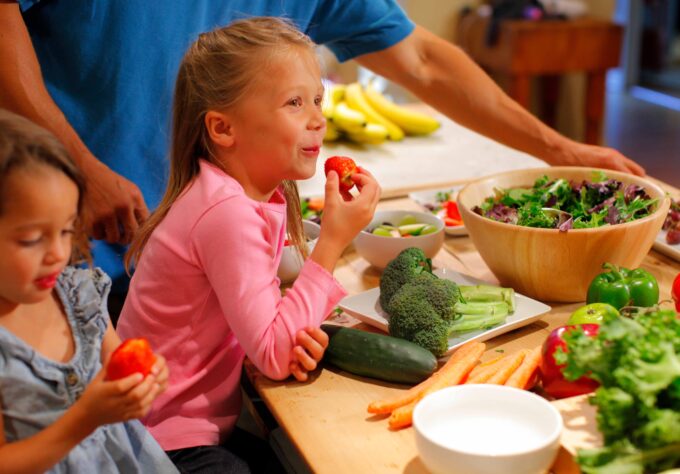Smoothies can be an easy and fun way to incorporate various foods into your child’s diet. Understanding the potential benefits of smoothies, how to prepare them, and when and how to incorporate them can make an enjoyable and healthy option for the whole family!
Benefits of Smoothies
There are several reasons you may choose to incorporate smoothies into their child’s daily or weekly routine. A few nutritional benefits to smoothies can include:
- Increased variety of fruits and vegetables: Sometimes children will accept a wider variety of fruits and vegetables in a blended form more than they will in the whole food form. It is still important to continue to expose your child to the whole food form on a consistent basis even if they are consuming the fruit/vegetable in the smoothie.
- Boost of vitamins, minerals, and antioxidants: Smoothies often combine several fruits and vegetables in one recipe giving a great boost of vitamins, minerals, and antioxidants.
- Increasing fiber intake: Blending fruits and vegetables, rather than juicing, retains their fiber content. Additional smoothie ingredients such as nuts, seeds, flaxseed, and chia seeds can boost fiber further. Increasing fiber intake can help with the feeling of fullness and support bowel regularity.
- Balance in a cup: Including fruits, vegetables, dairy/dairy alternative, nuts/seeds, and/or grains is a great option for a balanced snack or wholesome addition to a meal. A well-balanced smoothie could also be used as standalone breakfast item as long as it contains a protein source to ensure satiety.
- Source of calcium and vitamin D to support bone health: Use a calcium/vitamin D fortified liquids as the smoothie base, such as cow’s milk or plant alternative milks. Adding yogurt gives the smoothie a boost of protein and is a great source of calcium.
Watch out!
There are some things to keep in mind when preparing or purchasing a smoothie. Smoothies can very easily become a source of added sugars. The American Academy of Pediatrics (AAP) recommends that children under 2 years of age don’t consume any added sugars and children 2 years of age and older should have no more than 25gm (or 6 teaspoons) of added sugar daily.
A few reasons a smoothie can be high in added sugars and how to avoid:
- Use of fruit in syrups: Avoid this by using fresh or frozen fruit (with no added sugars)
- Using juice as the liquid base: Avoid this by using water, coconut water, milk, or unsweetened plant based milk.
- Using flavor syrups such as chocolate or strawberry syrup: Avoid this by letting the fruits and vegetables spice up the flavor for you! Try boosting the flavor with vanilla extract or unsweetened cocoa powder, cinnamon, or nut butter.
- Adding sugar or honey for sweetness: Avoid this by using variety of fruits, dates, or date paste with no sugar added as a natural sweetener.
When Should I Give My Child A Smoothie?
- Smoothies can be a source of balanced nutrition, but it is important to keep in mind that they do provide additional calories to a child’s diet.
- Smoothies can be used in place of a snack, or as a part of a meal. Since smoothies provide additional calories, nutrients, and fiber, it should be used as a part of a meal rather than the beverage at the meal.
- Smoothies can be a great calorie booster for children requiring extra calories to support growth. The addition of whole fat dairy and healthy fats can provide additional calories when it is appropriate to do so.
- Include your child when preparing the smoothie! This is a great way to expose them to various fruits, vegetables, and other ingredients.
Always consult your child’s physician or dietitian for individualized guidance for your child.
Create Your Own Smoothie
Step 1: Choose a Base (4-8oz) +/- Ice
- Water
- Unsweetened Almond Milk
- Coconut Water
- Cow’s Milk
- Soy Milk
Step 2: Choose 1-3 Fruits (1/2–2 cups, fresh/frozen)
- Strawberries
- Blueberries
- Banana
- Raspberries
- Blackberries
- Pineapple
- Peaches
- Cherries
- Apples
- Honeydew
- Kiwi
- Papaya
- Watermelon
Step 3: Choose 1 Vegetable (1/2-1 cup fresh/frozen/cooked)
- Kale
- Carrot
- Spinach
- Sweet potato
- Pumpkin
- Cauliflower
Step 4: Choose 1-2 Proteins/Fats
- 1-2 Tbsp Nut butter
- 1/2 to 1 Tbsp Ground flaxseed
- 1/2-1 Cup regular or Greek Yogurt
- 1/2 to 1 Tbsp Ground chia seed
- 1/4 Cup Tofu
- 1-3 Tbsp Hemp hearts
- 1/4 Avocado
These are just some ideas! Have fun and get creative with your smoothies!
Sample Smoothie Recipe:
Fruity Nut Smoothie
- 4oz of 2% milk
- 1/2 cup frozen strawberries
- 1/2 banana
- 1 Tbsp peanut butter
- 1/2 Tbsp ground flaxseed
- Ice
Learn More
Nutrition (nemours.org)
Healthy Eating (nemours.org)



